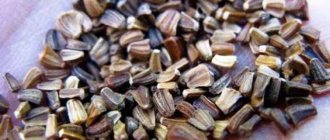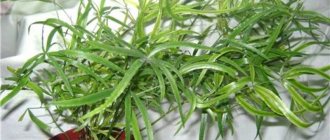Features of growing pitahaya from seeds at home
Pitahaya fruits are white pulp and have a sweet and sour taste.
Inside the fruit there are many small seeds that can also be eaten. Pitahaya tastes a little like kiwi, which we buy much more often. Growing this fruit at home is quite possible and even exciting, especially for those who love exotic plants. Dragon fruit is generally a cactus that grows in the subtropical zone, most often it can be found in deciduous forests with high humidity. The name is very unusual, but its appearance is also unusual - on its surface it has large scales, the tips of which are painted bright green. The fruit is not large in size, about the size of an apple, but the shape is more elongated. The pulp is white, red and purple.
This cactus plant grows quite quickly. If you provide support for the stems, they grow up to 6 m in height. Therefore, in its natural environment, pitaya climbs up the stems. This fruit originally appeared in America. The Indians were very fond of eating pitahaya, since they could simply pick it and eat it immediately, without any additional processing.
The name dragon fruit appeared for a reason. There were legends that described various battles involving dragons. They were so exhausted that they spat red fruits instead of fire.
How does pitahaya grow?
When you encounter pitahaya on a store counter, it is difficult to pass by - it is a very beautiful and unusual fruit. Something similar to a huge bright pink bud with green petals turned out over its entire area or a loose exotic cone. But the fruit is amazing not only on the outside, but also on the cut. If you cut it in half, in the “bowl” of a fairly thick inedible skin there will be slightly sweetish pulp filled with thousands of small, apple-shaped, black grains.
The taste of pitahaya, although not expressly sweet, is unique, unobtrusively refreshing. To some, it resembles a mixture of kiwi and banana, to others, an unsweetened pear with hints of kiwi. However, the taste may vary depending on the color of the inside of the fruit. Pitahaya with a white center is less sweet, while one with a dark crimson center has a more expressive taste. But the similarity with kiwi is rather not due to the taste, but rather to the presence of a huge number of seeds, which is why the pulp resembles kiwi in consistency.
Whose fruit is this, pitahaya? It turns out that pitahaya, pitaya, dragon fruit, dragon heart, dragonfruit is the name of the fruits of liana-shaped cacti belonging to the genus Hylocereus . These are cacti that are epiphytes - plants that live on other plants.
In nature, these species grow in South, Central America and Mexico. They are grown on a production scale on specialized farms in Southeast Asia (Thailand, Vietnam, the Philippines, etc.), as well as in Japan, China and Israel.
In general, these are 15 species, distinguished by trihedral, chaotically branching, rather weak but long shoots, reaching 10–12 m, which can grow both on the ground and, thanks to the large number of aerial roots, on trees. Often these shoots, with a diameter of 2 to 12 cm, are covered with short, up to 1 cm, soft needle-like or bristle-like spines, but they can also be without them.
Hylocereus blooms with the largest flowers in the world of cacti - with a diameter of 10 to 40 cm. Each of them is unusually fragrant, but lives only one night and is pollinated by nocturnal insects.
Hylocereus sinuous, or wavy (Hylocereus undatus).
Flowering begins in February and continues until July, allowing for 5-6 harvests from plants in six months, which in total provides a production yield of about 30 tons per hectare. The fruits, depending on the type, differ in size, skin color and pulp. They can be pink, purple or yellow, reach a length of up to 15 cm, and weigh up to 300-400 g.
The following varieties have been introduced into industrial culture: Hylocereus undatus (Hylocereus undatus) has red fruits with white or red flesh, Catarican Hylocereus has purple fruits with scarlet flesh, and Hylocereus megalanthus has yellow fruits with white flesh.
Pitahaya propagation
It propagates by seeds, cuttings or grafting. This plant is not difficult to grow at home, but for this you must have a closed greenhouse with suitable soil. Pitaya grows quite quickly and bears fruit. If you want to grow cacti for decorative purposes, then plant seeds. Moreover, this is one of the easiest ways. But if possible, then you can plant the stem of a plant that was brought from his native lands. Pitaya is not whimsical and will quickly take root.
Seeds are sold in stores, but if you collect your own, it will be much better, since they will be fresh and most likely they will all grow.
Growing pitahaya at home with seeds
Before you engage in actual cultivation, you need to prepare the seeds. When the seeds are thoroughly cleaned of pulp, you need to wait until they are completely dry. It is best if the material is collected from unripe fruits. A good soil for growing seeds is compost or potting mix. Young pitaya sprouts are usually visible within a couple of weeks. The main problem in care will be excessive watering. When the pitahaya grows taller and taller, it will be necessary to provide some kind of support for it so that the plant can rise. When pitahaya grows to 4 kg in weight, it begins to form buds.
Pitaya loves pollinators in the dark, so it opens only at night and closes during the day. Pollinate by butterflies or bats. If pollination is successful, the plant can reproduce quickly.
How to choose a fruit for planting a seed
The main problem is to get the basis for growing an exotic tree. Not all cities can find the "dragon's eye". If you are lucky enough to buy an Asian exotic fruit in a hypermarket, then you can safely experiment and plant a longan seed.
Important details:
- the riper the fruit, the higher the chances of germination;
- the best option is to buy and save an unusual fruit during a trip to Thailand, China or another eastern country in this region;
- the suitable period is mid-summer, when the fruits ripen well;
- supermarkets in our regions most often sell unripe fruits, which significantly reduces the germination rate;
- If a seed from an unripe longan does not germinate within an average period, do not despair. You need to wait another 14–16 days: perhaps the base will hatch later.
How to prepare seeds
To plant pitahaya, you first need to prepare the seeds. They are sold in stores, or you can assemble them yourself. Seeds collected from fresh fruit will produce strong shoots that will produce a healthy, strong plant. To get the seeds, you need to do the following:
- Mash the fruit well;
- fill it with water and let it sit for about an hour;
- pass the pulp through a fine sieve more than once;
- Dry the remaining seeds in a dry place for two to three days.
Make sure that there is no pulp on the seeds, as otherwise they may rot in the ground.
It is best to plant pitahaya in winter, in January or February.
Step-by-step instructions for planting seeds:
- buy soil in the store that is intended for succulents;
- Place drainage in the bottom of the pot;
- treat the soil with a biofungicide;
- place the seeds in the ground to a depth of no more than 1 cm, add a little water;
- make a greenhouse, cover the pot with film or a jar.
At a temperature of +20...+22 °C, the first seedlings will appear in 7-10 days. After about 30-35 days, i.e. a month, small needles will appear on the succulent. At this time, replant it in a larger pot, where the soil will be moistened. The ambient temperature needs to be reduced slightly, water the soil regularly.
Landing
Pitahaya is grown at home from freshly collected seeds, but dried seeds retain the ability to germinate for some time.
Pitaya pulp contains small seeds that are thoroughly washed before planting.
To plant, you need to thoroughly mash the pulp taken from the ripe fruit, add plain water and let it stand for some time. Then strain through very small mesh sieves. This procedure should be repeated several times so that the seeds are completely freed from the pulp. If even a little pulp remains on the seeds, later, after planting, they will not germinate, as the process of decay will begin.
Well-washed pitahaya seeds are dried and after a few days planted in soil pre-treated with a biofungicide to eliminate possible mold formation.
Seeds are planted in soil, which in its composition is intended for succulent plants (able to store moisture). A pot with soil for a future plant must have a drainage layer at the bottom. When sowing, the top layer of soil is moistened, with the expectation that moisture will penetrate into the soil no more than two-thirds in depth. After planting the seeds, the pot is covered with a transparent material (glass, plastic, polyethylene) to create greenhouse conditions.
Pitaya grown in a pot from seeds
The first shoots appear after the first week, and plants suitable for transplantation appear after 4 weeks. After this, the young plants are planted in separate pots for further growth and development. In the future, the plants can be kept in a cool room with constant soil moisture.
Pitahaya can also be propagated by cuttings, but an adult plant reacts painfully to cuttings being taken from it.
Soil and its care
In the warm and hot period of the year, that is, from spring to autumn, pitahaya needs to be watered more often. But when it’s already cool outside, that is, from autumn to spring, watering is practically not needed. It is with this watering regime that flowers will form best. But make sure that the soil is not too wet, as the roots may rot.
During growth and development, pitaya needs to be fertilized. Purchase store-bought fertilizer designed for succulents, or cactus fertilizer will also work.
When it gets hot, keep the plant in a room where the temperature is no higher than +25 °C. If the temperature drops sharply to zero, then this is not a problem for pitahaya, but at such times do not water at all.
The succulent does not require lighting, so it can easily grow in poorly lit places. For example, in summer, take the plant out into the garden and place it under a tree in the shade, where the air is well ventilated. Protect pitahaya from drafts and make sure that birds do not peck your fruit.
What conditions are needed to grow at home?
The tropical plant “Dragon's Eye” takes root well in the apartment. In the southern regions (Krasnodar Territory, the Caucasus, other zones with a similar climate), longan grows successfully in a tub in the fresh air during the warm season.
Five conditions for growing a tropical plant:
- The duration of daylight is 12 hours, no less.
- Regular feeding.
- The temperature in the home or outside is +24°C and above.
- Regular, high-quality moistening of the substrate and leaves so that all parts of the tropical tree receive enough moisture.
- A spacious pot in which powerful roots will not be too crowded.
Feeding pitahaya
The plant often needs feeding because it grows quickly; during the first year it can stretch as much as a meter. Pay attention to how much fertilizer you add. Sprinkle approximately 3-4 grams of dry fertilizer, mixing with one liter of water.
Due to the fact that pitaya grows quickly, it can be difficult to get its appearance in order; long stems lie on the ground, stretch across the entire width, and the appearance is not entirely neat. To make everything look neater, you need to drive a stick into the ground in a pot and tie the stems to it.
When flowers begin to appear on the plant, it means that there will soon be fruits. But you will have to wait a lot of time; it happens that only after 5-6 years the pitahaya will delight its owner with delicious fruits.
Pitahaya growing at home from seeds, photo
Among the very large list of exotic fruits available to the modern consumer in store windows, the fruit such as pitahaya especially stands out for its original appearance. It is also called dragon fruit or pitaya . The incomprehensible appearance and high price of this delicacy latently prompt the client to think that growing such a miracle is a very, very difficult task. However, after reading the materials in this article, you will be able to make sure that this is not correct.
Photo of dragon heart fruit
Dragon eye fruit is often confused with dragon heart fruit. However, these are two completely different fruits that are not even remotely similar to each other. “Dragon's Heart” is also called pitahaya or pitaya. It has a very bright and attractive appearance. Its color is bright pink, and its body is covered with scales with bright green tips. The plant itself belongs to the Cactus family. Inside the fruit there is juicy pulp with many small black seeds. The color of the flesh can be white or bright purple.
Fruit “Dragon”: front and profile photos
Growing characteristics and care
Getting to the most basic question of this article, we must immediately say that this plant can only be propagated by sowing seeds in the soil; all other methods do not give a clear result and very often will only waste your time.
So, we describe the landing process step by step:
- You need to remove the seeds from a ripe pitaya fruit. To do this, you need to mash the fruit thoroughly and fill it well with water. Then strain everything through cheesecloth and repeat this process a couple more times so that the seeds are completely freed from the remnants of the fruit.
- Then, in a pot with soil for succulents poured into it in advance and a drainage layer at the bottom, use your finger to make a hole 1-1.5 centimeters deep.
- Several seeds are placed in the hole, preferably about 3-5 pieces at a time, but since they are extremely small, it will be more convenient to separate a piece the size of a match head from the entire mass.
- Then the hole is poured, the soil is watered with water in the calculation that it will saturate only 2/3 of the entire soil layer, the pot is covered with polymer ethylene or glass to create conditions similar to those in a greenhouse.
- It is best to place the pot in the sun, ensure a stable temperature of at least +23°C, water the soil as it dries, but no more than once every 2 days.
- In 7 days, the first triangular shoots of the cactus should appear. And after a month you will receive plants ready for transplanting to a permanent place.
Pitahaya in adulthood is not considered very demanding in relation to the conditions of its own maintenance, it is not demanding of lighting, and it also does very well, like any other cactus, without watering and fertilizing. However, if you want to constantly receive fruits from it, you will need to work hard.
As already mentioned until recently, pitahaya is quite relaxed about lighting and can grow even in a very roomy corner, however, in order to intensify the processes of photosynthesis and accelerate the onset of fruiting, it is recommended to place it closer to the sun.
The plant does not suffer from drafts and wind, and therefore in warm weather you can safely leave it on the balcony or an extension to the house.
This plant tolerates lack of watering without any problems, but in the warm season, especially if you live in an area where the temperature exceeds +40°C, it is better not to abuse this, watering the plant as the soil dries 1 cm.
In winter, pitaya can be kept in a cool room, since it can keep the temperature down to 0°C, but the main thing is not to overwater it, because excessive moisture in cold weather is dangerous for the development of various diseases of a fungal nature.
At first, you need to feed pitahaya especially often, because it grows actively and can add up to one meter in height during the first year of its life. The most suitable fertilizer for exotic plants is specialized fertilizers for cacti, which you can buy at absolutely any flower shop, for example, Kemira-Lux.
One thing worth keeping in mind is the amount of feeding. For proper development, this succulent will need 3-4 grams of dry fertilizer per 1 liter of water for every second watering.
Due to excessively rapid growth, it is sometimes impossible to get the appearance of your cactus in order: its stems spread along the ground, fill up a lot of free space and look rather careless. Therefore, in order to normalize the aesthetic component of pitaya content, it is recommended to fix the stems to a bamboo stick stuck into the pot.
The first signal that a plant is ready for fruit to appear is the appearance of flowers. But this process is very slow, sometimes it can take up to 5-7 years.
Characteristics of pitahaya. What you need to know before boarding
Pitaya is a cactus whose character differs from other inhabitants of the dry and hot equatorial climate. The plant can develop normally even without an abundance of sun. True, it still needs light to bear fruit. In the middle zone, pitahaya is grown in large pots, taken out to a shady garden for the summer. Characteristics of Dragon Fruit:
- height in the wild - about 10 m;
- succulent shoots - falling from the top of the vine, in some varieties - curly;
- The flowers are large, 17 cm in diameter, usually white, very fragrant, and open at night.
Attention! In indoor conditions, flowering and fruiting of a cactus occurs no earlier than 5-7 years of life. At this point, the plant reaches a weight of about 4 kg.
Lengthening daylight hours stimulates flowering. Therefore, you will have to illuminate the culture in the dark. This practice was successfully introduced in Vietnam, where today pitahaya is grown on an industrial scale. Fruit ovaries appear on the cactus after 1-1.5 months. after the flowers fade. But under favorable conditions, the plant will delight you with fruits up to 5-6 times a season.
Pitaya cactus
Pitaya fruits are covered with large, smooth growths-scales. Depending on the type, the peel may be colored a mixture of pink and light green. Cactus fruits are oblong and do not exceed the size of an apple. Under the skin they have white, red or dark purple pulp, dotted with small black seeds. The average weight of ripe dragon fruit is 150-600 g.
Contraindications for consumption
Like any other exotic fruit, pitahaya should be eaten with great caution for the first time, because it is not known exactly what unpleasant undesirable effects its composition may lead to. For example, it is possible to develop flatulence, heartburn or a full-fledged allergy, even to the point of Quincke's edema.
Therefore, do not rush, first eat a very small piece, wait 10-15 minutes, and only then finish the rest.
It is undesirable to consume this product by people who have a predisposition to a wide variety of diseases of allergic etiology, incl. to bronchial asthma, dermatitis, nonspecific ulcerative colitis and urticaria. People who suffer from gastritis, enteritis or peptic ulcer of the stomach and duodenum in the acute phase should refrain from including pitaya in the menu.
This fruit should not be given to children under the age of ten, because they have a fairly high risk of developing allergies.
It is recommended that breastfeeding mothers eat pitahaya very carefully, because antigens from the fruit can enter the child’s body through milk and incite the development of allergies. It is permissible to consume less than 4-5 fruits per day, otherwise the likelihood of developing diarrhea increases.
So, we hope that, guided by this publication, you will be able to grow excellent pitahaya for yourself. Do not forget that no exotic fruits, even the most outlandish ones, essentially stand out in any way in matters of growing and caring for plants that are native and ordinary to our hearts. This means having fun with strange and unusual plants to your heart’s content, you can acquire a skill that will subsequently serve you well in your summer cottage or garden. Good luck to you and your plants!
How to grow pitahaya
Today we will talk about an exotic guest from Mexico - pitahaya. This fruit is also known in different countries as dragon fruit, strawberry pear, dragon crystal, green dragon, dragon pearl. Just look at a plant from the cactus genus - it can decorate any home. Read our article on how to grow such a plant on your windowsill.
Benefits of pitahaya
Pitachoya is a valuable low-calorie fruit with a high content of nutrients. The pulp of the exotic fruit contains mainly water, carbohydrates and a small amount of polyunsaturated fats. In addition, it is rich in antioxidants, vitamins B1, B2, B3, PP, C and microelements - phosphorus, iron, calcium and others.
Numerous studies have shown that the fruit has a beneficial effect on the cardiovascular and endocrine systems. The fruit can be consumed by hypertensive patients and those suffering from diabetes - it reduces blood glucose levels. The pulp of the fruit is easily absorbed by the body, so it can be used to relieve intestinal disorders and bloating. Useful for people with poor eyesight.
How to grow pitahaya
The plant, bred in Mexico, is now successfully grown in the following countries: Cambodia, Thailand, Taiwan, Malaysia, Sri Lanka, Vietnam, Indonesia, Bangladesh, the Philippines, Hawaii, Cyprus, Israel and South China.
Interestingly, the pitahaya cactus grows and blooms only at night. The plant has beautiful white flowers, characteristic of plants of the cactus genus. Pitahaya can be grown not only as a fruit-bearing tree, but also as an ornamental plant - it will perfectly decorate your garden and home with its exotic and unusual beauty.
Pitahaya can be grown from seeds and cuttings - it grows quite well indoors in a pot or greenhouse. If you follow all the rules of care, cacti actively grow, bloom and bear fruit at home. The most affordable way to get a cactus plant at home is to grow it from seeds.
Preparing and sowing seeds. Step-by-step instruction:
- Take seeds from ripe fruit or purchased from a specialty store.
- Take some of the pulp with seeds, place it in cheesecloth and rinse under running water.
- The peeled seeds do not need to be dried, but can be immediately planted in the soil.
- To germinate pitahaya seeds, use a large pot or flat tray with drainage holes. For soil, use sand, peat, vermiculite or perlite in equal proportions.
- Fill the container with drainage layer and soil. Distribute the seeds evenly over the surface of the soil. Sprinkle the seeds with a small amount of soil just to cover them.
- Cover the container with plastic wrap to create a humid microclimate. Stick to a temperature of +22+25 degrees. Lift the film twice a day to ventilate the crops.
- Water with a spray bottle after the soil dries.
Within 2-3 weeks, the seeds will germinate and the polyethylene cover will need to be removed. Move the pot to a well-lit place, but avoid direct sunlight. A month after sowing, the seeds can be transplanted into separate pots. Keep plants in a cool room by regularly moistening the soil.
Features of planting pitaya
Seeds are used for planting plants. Freshly collected specimens are more effective at germinating, but dried ones can also germinate. It is not difficult to obtain seeds from ripe fruit. For this:
- Mash the pulp thoroughly;
- fill with water and leave for a while;
- strain several times using a fine sieve;
- dry the seed for several days.
Attention! It is important to completely free the seeds from the pulp. Otherwise, they may rot in the early stages of the growing season.
Planting is best done in January-February:
- Prepare special soil for succulents for planting.
- Place a drainage layer at the bottom of a large pot or container.
- Disinfect the soil with any biofungicide.
- Deepen the seeds into the soil 1 cm, water lightly.
- Cover the container with glass or film, building a greenhouse.
Pitahaya fruit in section
At room temperature, the seedlings should hatch in about a week. In about a month, the first needles will grow on the succulent. Now you can plant it in a separate pot with moist soil. For soil, use the same succulent substrates or substrates enriched with peat and organic fertilizers. Reduce the temperature and moisten the soil regularly.
Pitahaya care
Like other cacti, pitahaya is not picky and can grow in the corner of an apartment. From the beginning of spring to the end of summer, pitahaya needs regular watering, and in the autumn-winter period it is stopped. Overwatering threatens root rotting. During short-term cold snaps, which the plant tolerates normally, pitahaya does not need to be watered.
During the warm period, plants should be kept in a room with a temperature of +25 degrees. In winter, take the pot of pitahaya indoors with an index of +17 degrees. Despite the fact that pitahaya's relatives grow in hot deserts in dry and warm climates, it also grows well in shaded areas or rooms with diffused sunlight. If possible, in warm summers you can take pots with plants into the garden under shady trees.
A fast-growing cactus requires frequent and regular feeding. During the period of active growth, from spring to autumn, pitahaya is fed with fertilizer marked “for succulents”.
You can expect domesticated pitahaya to bloom in 5-7 years. Good and continuous illumination of the room will play an important role in the formation of flowers. To wait for fruits from a home cactus, it is necessary to ensure cross-pollination, so there should be at least two pitahaya plants in the house.
Growing pitahaya at home: video
Pitaya, otherwise known as “pitahaya”, “dragon fruit”, is one of the exotic plants that grows at home. Its fruit has white pulp with a sweet and sour taste, which contains many small edible seeds. The taste of pitaya can be compared with the taste of kiwi, which is better known to domestic consumers. Growing pitahaya at home is a fascinating process for every lover of exotic plants at home.
Cut Pitaya
Features of growing pitahaya from seeds at home
Pitahaya fruits are white pulp and have a sweet and sour taste. Inside the fruit there are many small seeds that can also be eaten. Pitahaya tastes a little like kiwi, which we buy much more often. Growing this fruit at home is quite possible and even exciting, especially for those who love exotic plants.
Dragon fruit is generally a cactus that grows in the subtropical zone, most often it can be found in deciduous forests with high humidity. The name is very unusual, but its appearance is also unusual - on its surface it has large scales, the tips of which are painted bright green. The fruit is not large in size, about the size of an apple, but the shape is more elongated. The pulp is white, red and purple.
This cactus plant grows quite quickly. If you provide support for the stems, they grow up to 6 m in height. Therefore, in its natural environment, pitaya climbs up the stems. This fruit originally appeared in America. The Indians were very fond of eating pitahaya, since they could simply pick it and eat it immediately, without any additional processing.
The name dragon fruit appeared for a reason. There were legends that described various battles involving dragons. They were so exhausted that they spat red fruits instead of fire.
What are the benefits of Hylocereus fruits?
Nutritionists consider pitahaya to be a fairly healthy and low-calorie product. There are only 45 kcal per 100 g of its berry-shaped fruits. The minerals and vitamins included in the composition make it possible to recommend them for increasing immunity, strengthening the cardiovascular system, improving the functioning of the digestive system, lowering cholesterol levels, and improving the health of the skin. However, we often eat them not as medicinal fruits, but as exotic fruits.
Pitahaya can be eaten raw by cutting it in half and scooping out the pulp with a spoon, or by cutting it into slices. You can make smoothies from it, add the pulp to freshly squeezed drinks and yoghurts. At home, it is used to produce marmalade, jelly, wine, juices, and sweets. Used for baking. Used as a seasoning. In southern China, Hylocereus flowers are also eaten and added to vegetable soups.
By the way, Hylocereus undulata is grown in China not only as a source of nutritious fruits, but also as a plant for forming hedges.
Pitahaya propagation
It propagates by seeds, cuttings or grafting. This plant is not difficult to grow at home, but for this you must have a closed greenhouse with suitable soil. Pitaya grows quite quickly and bears fruit. If you want to grow cacti for decorative purposes, then plant seeds. Moreover, this is one of the easiest ways. But if possible, then you can plant the stem of a plant that was brought from his native lands. Pitaya is not whimsical and will quickly take root.
Seeds are sold in stores, but if you collect your own, it will be much better, since they will be fresh and most likely they will all grow.
Growing pitahaya at home with seeds
Before you engage in actual cultivation, you need to prepare the seeds. When the seeds are thoroughly cleaned of pulp, you need to wait until they are completely dry. It is best if the material is collected from unripe fruits. A good soil for growing seeds is compost or potting mix. Young pitaya sprouts are usually visible within a couple of weeks. The main problem in care will be excessive watering. When the pitahaya grows taller and taller, it will be necessary to provide some kind of support for it so that the plant can rise. When pitahaya grows to 4 kg in weight, it begins to form buds.
Pitaya loves pollinators in the dark, so it opens only at night and closes during the day. Pollinate by butterflies or bats. If pollination is successful, the plant can reproduce quickly.
How to prepare seeds
To plant pitahaya, you first need to prepare the seeds. They are sold in stores, or you can assemble them yourself. Seeds collected from fresh fruit will produce strong shoots that will produce a healthy, strong plant. To get the seeds, you need to do the following:
- Mash the fruit well;
- fill it with water and let it sit for about an hour;
- pass the pulp through a fine sieve more than once;
- Dry the remaining seeds in a dry place for two to three days.
Make sure that there is no pulp on the seeds, as otherwise they may rot in the ground.
It is best to plant pitahaya in winter, in January or February.
Step-by-step instructions for planting seeds:
- buy soil in the store that is intended for succulents;
- Place drainage in the bottom of the pot;
- treat the soil with a biofungicide;
- place the seeds in the ground to a depth of no more than 1 cm, add a little water;
- make a greenhouse, cover the pot with film or a jar.
At a temperature of +20...+22 °C, the first seedlings will appear in 7-10 days. After about 30-35 days, i.e. a month, small needles will appear on the succulent. At this time, replant it in a larger pot, where the soil will be moistened. The ambient temperature needs to be reduced slightly, water the soil regularly.
Sowing pitahaya seeds
In order to grow this cactus at home, it is enough to collect seeds from pitahaya, dry them and let them lie for a while. Then soak for 5-6 hours in warm water, first wrapped in a napkin or cloth, and sow on top of a pre-prepared substrate. Next, you need to lightly sprinkle the seeds with sifted soil and compact them for better adhesion to the ground, and therefore accelerate germination. Afterwards, water the crops with a spray bottle and cover with film. Please note that within two years the germination of seeds is lost.
Next, the pot must be placed in diffused light and kept at a temperature of +20...+25 °C, periodically ventilating the greenhouse so that a lot of moisture does not accumulate under the film. You need to ensure that the soil is always moist, but not wet. And wait - shoots will appear in 15-25 days.
The substrate for Hylocereus needs to be nutritious and at the same time very light and quite acidic (pH 5.5). You can prepare it yourself from 1 part of deciduous soil, 1 part of peat, which can be replaced with coconut fiber, 1 part, crushed to 0.2-0.5 mm in diameter, pine bark, and 2 parts of sand or vermiculite. Or take a simpler composition - 70% leaf soil and 30% sand. It can be simpler - buy a substrate for cacti.
After the plants grow up, they need to be transplanted into separate containers. Pots for this type of cacti are chosen to be of medium size, since they grow quickly and have a fairly large root system. To obtain a more lush plant, several seedlings are planted in one.
We collect seeds from pitahaya.
Dry the pitahaya seeds and let them sit for a while.
Soil and its care
In the warm and hot period of the year, that is, from spring to autumn, pitahaya needs to be watered more often. But when it’s already cool outside, that is, from autumn to spring, watering is practically not needed. It is with this watering regime that flowers will form best. But make sure that the soil is not too wet, as the roots may rot.
During growth and development, pitaya needs to be fertilized. Purchase store-bought fertilizer designed for succulents, or cactus fertilizer will also work.
When it gets hot, keep the plant in a room where the temperature is no higher than +25 °C. If the temperature drops sharply to zero, then this is not a problem for pitahaya, but at such times do not water at all.
The succulent does not require lighting, so it can easily grow in poorly lit places. For example, in summer, take the plant out into the garden and place it under a tree in the shade, where the air is well ventilated. Protect pitahaya from drafts and make sure that birds do not peck your fruit.
Transfer
Important details:
- Be sure to select a large pot for the longan so that the roots grow for a long period in one container.
- The capricious tropical species does not like frequent transplants; you need to think in advance about a suitable flower pot.
- When the root system grows so much that it is cramped in the old container, they select a large container, transfer the plant, and maintain the integrity of the earthen ball. The less the housewife disturbs the roots, the higher the likelihood that the plant will take root well after transplanting into a new pot.
- Abundant watering of the soil before transshipment of the plant will help to avoid soil drying out.
- No fertilizing or watering is carried out during the week; the plant is kept in a warm room, but away from direct sun.
Feeding pitahaya
The plant often needs feeding because it grows quickly; during the first year it can stretch as much as a meter. Pay attention to how much fertilizer you add. Sprinkle approximately 3-4 grams of dry fertilizer, mixing with one liter of water.
Due to the fact that pitaya grows quickly, it can be difficult to get its appearance in order; long stems lie on the ground, stretch across the entire width, and the appearance is not entirely neat. To make everything look neater, you need to drive a stick into the ground in a pot and tie the stems to it.
When flowers begin to appear on the plant, it means that there will soon be fruits. But you will have to wait a lot of time; it happens that only after 5-6 years the pitahaya will delight its owner with delicious fruits.
{SOURCE}











